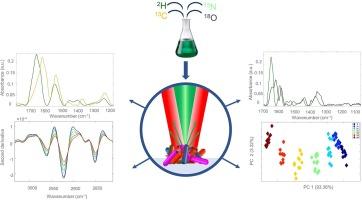Application of infrared spectroscopy to study carbon-deuterium kinetics and isotopic spectral shifts at the single-cell level
IF 4.3
2区 化学
Q1 SPECTROSCOPY
Spectrochimica Acta Part A: Molecular and Biomolecular Spectroscopy
Pub Date : 2024-11-03
DOI:10.1016/j.saa.2024.125374
引用次数: 0
Abstract
Microbial communities play crucial roles in shaping natural ecosystems, impacting human well-being, and driving advancements in industrial biotechnology. However, associating specific metabolic functions with bacteria proves challenging due to the vast diversity of microorganisms within these communities. In the past decades stable isotope probing (SIP) approaches, coupled with vibrational spectroscopy, have emerged as a novel method for revealing microbial metabolic roles and interactions in complex communities. In this study, we employed various combinations of heavy stable isotopes (D, 13C, 15N, and 18O), to evaluate all possible isotopic spectral shifts in the mid-IR region using Fourier-Transform Infrared (FT-IR) and Optical Photothermal Infrared (O-PTIR) spectroscopy, at both community and single-cell levels. Additionally, we conducted a time-course study to explore the kinetics of C![]() D vibration in Escherichia coli bacteria, allowing time-based sampling and assessment of isotopic labeling kinetics. The FT-IR and O-PTIR, along with the second derivative spectra of E. coli cells cultured in minimal medium supplemented with various combinations of heavy isotopes exhibited notable similarities. Several spectral shifts in primary vibrational peaks were observed due to the incorporation of heavy isotopes into various biomolecules. Remarkably, the incorporation of deuterium into amide groups, resulting in the formation of nitrogen-deuterium bonds, caused a shift in amide A and B into the silent region, overlapping with C
D vibration in Escherichia coli bacteria, allowing time-based sampling and assessment of isotopic labeling kinetics. The FT-IR and O-PTIR, along with the second derivative spectra of E. coli cells cultured in minimal medium supplemented with various combinations of heavy isotopes exhibited notable similarities. Several spectral shifts in primary vibrational peaks were observed due to the incorporation of heavy isotopes into various biomolecules. Remarkably, the incorporation of deuterium into amide groups, resulting in the formation of nitrogen-deuterium bonds, caused a shift in amide A and B into the silent region, overlapping with C![]() D signature peaks. The incorporation of 18O into the ester group of lipids and the carbonyl group of proteins resulted in a notable shift to the lower wavenumber region. Additionally, the second derivative of FT-IR spectral data highlighted the integration of 18O into α-helix and β-sheet structures. Furthermore, the spectra, second derivative, and PC-DFA scores and loadings plot of FT-IR data collectively illustrated the practicality of monitoring 13C and D incorporation into E. coli bacterial cells within the first 30-min incubation period. The findings of this study suggest that FT-IR and O-PTIR can serve as efficient tools for monitoring the incorporation of heavy isotopes into bacteria at both the population and single-cell levels. Additionally, the SIP approach allowed us to assign two new deuterium-associated vibrational peaks to their corresponding functional groups, which to the best of our knowledge have not been reported previously.
D signature peaks. The incorporation of 18O into the ester group of lipids and the carbonyl group of proteins resulted in a notable shift to the lower wavenumber region. Additionally, the second derivative of FT-IR spectral data highlighted the integration of 18O into α-helix and β-sheet structures. Furthermore, the spectra, second derivative, and PC-DFA scores and loadings plot of FT-IR data collectively illustrated the practicality of monitoring 13C and D incorporation into E. coli bacterial cells within the first 30-min incubation period. The findings of this study suggest that FT-IR and O-PTIR can serve as efficient tools for monitoring the incorporation of heavy isotopes into bacteria at both the population and single-cell levels. Additionally, the SIP approach allowed us to assign two new deuterium-associated vibrational peaks to their corresponding functional groups, which to the best of our knowledge have not been reported previously.

应用红外光谱法研究单细胞水平的碳-氘动力学和同位素光谱偏移。
微生物群落在塑造自然生态系统、影响人类福祉以及推动工业生物技术进步方面发挥着至关重要的作用。然而,由于这些群落中的微生物种类繁多,将特定代谢功能与细菌联系起来具有挑战性。在过去的几十年中,稳定同位素探测(SIP)方法与振动光谱学相结合,已成为揭示复杂群落中微生物代谢作用和相互作用的一种新方法。在这项研究中,我们采用了各种重型稳定同位素(D、13C、15N 和 18O)组合,利用傅立叶变换红外光谱(FT-IR)和光学光热红外光谱(O-PTIR),在群落和单细胞水平上评估了中红外区域所有可能的同位素光谱偏移。此外,我们还进行了一项时间历程研究,以探索大肠杆菌中 CD 振动的动力学,从而实现基于时间的取样和同位素标记动力学评估。在添加了各种重同位素组合的最小培养基中培养的大肠杆菌细胞的傅立叶变换红外光谱、O-傅立叶变换红外光谱以及二阶导数光谱显示出明显的相似性。由于在各种生物大分子中掺入了重同位素,主振峰出现了一些光谱偏移。值得注意的是,氘掺入酰胺基团,形成氮-氘键,导致酰胺 A 和 B 向无声区移动,与 CD 特征峰重叠。在脂质的酯基和蛋白质的羰基中加入 18O 会导致明显的低波长区域移动。此外,傅立叶变换红外光谱数据的二次导数突出显示了 18O 与 α 螺旋和 β 片状结构的结合。此外,傅立叶变换红外光谱数据的光谱、二阶导数、PC-DFA 分数和载荷图共同表明,在头 30 分钟培养期内监测大肠杆菌细菌细胞中 13C 和 D 的掺入是切实可行的。本研究的结果表明,傅立叶变换红外光谱和 O-PTIR 可以作为在群体和单细胞水平上监测重同位素掺入细菌的有效工具。此外,通过 SIP 方法,我们还将两个新的氘相关振动峰分配给了相应的官能团,据我们所知,这两个振动峰以前从未报道过。
本文章由计算机程序翻译,如有差异,请以英文原文为准。
求助全文
约1分钟内获得全文
求助全文
来源期刊
CiteScore
8.40
自引率
11.40%
发文量
1364
审稿时长
40 days
期刊介绍:
Spectrochimica Acta, Part A: Molecular and Biomolecular Spectroscopy (SAA) is an interdisciplinary journal which spans from basic to applied aspects of optical spectroscopy in chemistry, medicine, biology, and materials science.
The journal publishes original scientific papers that feature high-quality spectroscopic data and analysis. From the broad range of optical spectroscopies, the emphasis is on electronic, vibrational or rotational spectra of molecules, rather than on spectroscopy based on magnetic moments.
Criteria for publication in SAA are novelty, uniqueness, and outstanding quality. Routine applications of spectroscopic techniques and computational methods are not appropriate.
Topics of particular interest of Spectrochimica Acta Part A include, but are not limited to:
Spectroscopy and dynamics of bioanalytical, biomedical, environmental, and atmospheric sciences,
Novel experimental techniques or instrumentation for molecular spectroscopy,
Novel theoretical and computational methods,
Novel applications in photochemistry and photobiology,
Novel interpretational approaches as well as advances in data analysis based on electronic or vibrational spectroscopy.

 求助内容:
求助内容: 应助结果提醒方式:
应助结果提醒方式:


